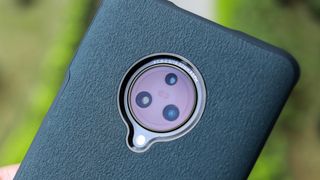Why you can trust TechRadar
Camera

The other notable aspect of the Vivo NEX 3 is the camera array. Placed in a round housing surrounded by Vivo’s iconic “Lunar rings” are three cameras at three different focal lengths. There’s a 64MP primary sensor with an f/1.7 aperture, augmented by a 13MP ultra-wide shooter and a 13MP telephoto lens.
The 64MP camera uses Samsung’s new ISOCELL Bright GW1 image sensor which has a big 1/1.7-inch sensor and a 0.8µm pixel size. By default, it uses pixel binning to combine four adjacent pixels to form a “superpixel” resulting in 16MP images with a 1.6µm pixel size for better performance in varying lighting conditions.







The primary camera had excellent dynamic range and colours were very accurate and pleasing to look at. Focus speeds were adequate too.






Switching to the ultra-wide sensor, the colour and dynamic range parity were very well maintained. Occasionally the images would be a little darker or soft, but that is expected with the smaller aperture. These differences become a lot more evident in darker conditions.




The telephoto lens added a cool perspective, but the results were very soft, and a tad oversaturated. It’s serviceable, but won’t blow you away.




Night Mode is present too, which would require you to hold the phone for 2 seconds where it takes multiple images and superimposes them to reveal details in the darker parts of the image. The results were definitely a lot better, with ample detail in the shadows without blowing the highlights. Noise levels would increase too in the more challenging situations, but the results were brighter than what we could see, which is a fair compromise.


Selfies are handled by a 16MP shooter that elevates from the top edge. This module also includes a front-facing flash for pictures and video calls in low-light conditions. The results were decent but not anything ground-breaking. Colours and dynamic range were above average but the sharpness was absent. This could be due to the fixed focus distance of the camera.
Battery and Charging

Flagship phones these days have once again started prioritizing battery capacities over slimmer form factors, and the Vivo NEX 3 is no outlier to this trend. Powered by a 4,500 mAh battery, the NEX provided one of the best battery backups we’ve tested on a flagship recently. FunTouch OS has always been great with efficiency and that was evident once again. On days with extreme usage which would involve around 3 hours of PUBG, along with the regular usage of calls, social media, video consumption and photography, the NEX 3 would still last an entire day. Moderate users can expect close to two days on a single charge.
In some markets, the Vivo NEX 3 comes with a 44W charger. However, our unit came with a 22.5W FlashCharger that would take the phone from empty to over 60% in 30 minutes, and to full in about an hour, almost as good as other high-end charging mechanisms around.
Software

It’s no secret that most Chinese OEMs ship their Android phones with a heavy customized skin on top, that is visually unoriginal, lacks an app drawer and changes the location of elements to unconventional places.
Vivo’s FunTouch OS is guilty of all of these crimes. It’s a heavy and confusing skin which changes how you respond to notifications, quick settings and app switching. Not just that, it looks like an old iOS rip-off, just more childish.
Normally, we’re not very critical of software skins as they are more of a personal preference, but for a high-end phone that looks so futuristic, one would rightfully expect a more robust software implementation that is a little different than the company’s budget smartphones.
One of our discussion points summed up the software experience on the Vivo NEX 3 really well: This is undoubtedly a beautiful phone, but that ends as soon as you unlock it.
Verdict

There are two ways to look at the Vivo NEX 3, and those will be based on how much of an early adopter you are when it comes to technology.
Either you will love the bold design choices that it brings before anyone else in the market, or you will look at it as just another Chinese company trying weird gimmicks to stand out from the crowd without covering the basics. Depending on which sample space you fall in, the Vivo NEX 3 might be a fascinating device for you or just another half-baked launch.
It needs to be considered that there’s no word on Indian pricing and availability, so we can’t comment on how it stands against the competition. It probably won’t be cheap, which is fine, as long as you value the innovation and upgrades Vivo has been able to introduce. Unique/concept products are not here to justify their price but are here to give us a glimpse at the future. Remember, the first pop-up camera phone was a concept.
- 1
- 2
Current page: Camera, Battery and charging, Software, Verdict
Prev Page Pricing and availability, Design, Display, PerformanceAakash is the engine that keeps TechRadar India running, using his experience and ideas to help consumers get to the right products via reviews, buying guides and explainers. Apart from phones, computers and cameras, he is obsessed with electric vehicles.

